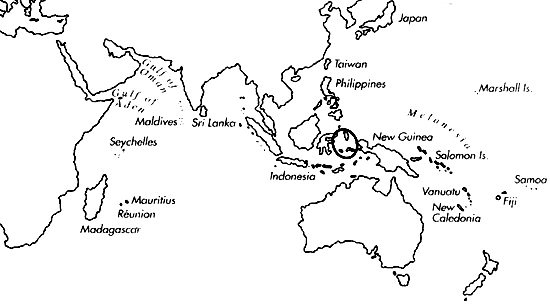
Skip Navigation Links
View access keys for this site.

Range: C. s. stramineus: Indonesia (Moluccas); C. s. mulderi: Philippines, Papua New Guinea, and Solomon Is.
Description: Medium-sized, moderately solid. Last whorl ventricosely conical, occasionally conical in C. s. stramineus (Pl. 40, Figs. 14-17) and conoid-cylindrical in C. s. mulderi (Pl. 40, Figs. 18-21), generally narrower in C. s. stramineus; outline convex adapically, less so to straight below; left side may be concave just above base. Aperture slightly wider at base than near shoulder in C. s. stramineus, more so in C. s. mulderi. Shoulder angulate to subangulate, sometimes rounded. Spire usually low in C. s. stramineus, of moderate height in C. s. mulderi; outline concave. Larval shell of 2.25-2.5 whorls, maximum diameter 0.6-0.8 mm. Teleoconch sutural ramps flat to slightly convex, occasionally slightly concave in late whorls, with 0 increasing to 3-7 spiral grooves; latest ramps may have additional spiral striae. Last whorl with spiral grooves on basal fourth to third, occasionally to centre; ribbons between broad posteriorly, narrower and alternating with wide grooves anteriorly.
| Shell Morphometry | ||
|---|---|---|
| L | - | |
| RW | - | |
| RD | - | |
| PMD | - | |
| RSH | - | |
Ground colour white to bluish grey. In C. s. stramineus, last whorl with rather regular spiral rows of yellowish or reddish brown dots, spots and bars that are also mostly aligned axially; markings fuse into discontinuous spiral bands below shoulder and above centre. In C. s. mulderi, last whorl pattern similar but with an additional spiral band within basal third, and markings seldom aligned axially. Siphonal fasciole white to pale violet in C. s. stramineus, white in C. s. mulderi. Larval whorls and a few adjacent postnuclear sutural ramps white to brown. In C. s. stramineus, following sutural ramps solid brown or with variably discrete radial streaks and blotches. In C. s. mulderi, following sutural ramps with separate reddish to dark brown radial streaks and blotches often extending over shoulder edge. Aperture light to dark or brownish violet; C. s. mulderi with an orange-brown collabral band.
Periostracum olive-grey, thin, translucent, smooth (C. s. mulderi).
Habitat and Habits: Shallow water.
Discussion: C. stramineus resembles C. iodostoma, C. sertacinctus, C. zebra, and C. zapatosensis. C. iodostoma differs in having its last whorl more finely patterned, with few to many rows of reddish brown dots and sometimes with wavy axial lines forming an irregular network. Its spiral rows lack the larger dots and bars of C. stramineus. C. sertacinctus is a somewhat smaller species (to 40 mm); its last whorl has beige background shades and lacks the predominant pattern of regular spiral rows of brown dots, spots and bars characteristic of C. stramineus. C. s. stramineus can be also distinguished by its usually narrower last whorl (RD 0.51-0.56 vs. 0.53-0.64) and its solid brown postnuclear sutural ramps. For comparison with C. zapatosensis and C. zebra, see the Discussions of those species. C. nisus Sowerby II was renamed C. stramineus amplus by Röckel and Korn (1992), as a geographic subspecies of C. stramineus (Röckel, 1987b). However, this subspecies had already been described in 1936 as C. mulderi, based on a subadult shell as holotype (Pl. 40, Fig. 21). The differences between C. s. stramineus and C. s. mulderi do not justify separation at the species level. C. alveolus and C. fuscomaculatus (Pl. 40, Fig. 17) are synonyms of C. s. stramineus.

C. stramineus range map
This section contains verbatim reproductions of the accounts of 316 species of Conus from the Indo-Pacific region, from Manual of the Living Conidae, by Röckel, Korn and Kohn (1995). They are reproduced with the kind permission of the present publisher, Conchbooks.
All plates and figures referred to in the text are also in Röckel, Korn & Kohn, 1995. Manual of the Living Conidae Vol. 1: Indo-Pacific Region.
The range maps have been modified so that each species account has it own map, rather than one map that showed the ranges of several species in the original work. This was necessary because each species account is on a separate page on the website and not confined to the order of accounts in the book.
Return to framed version (returns to search page)